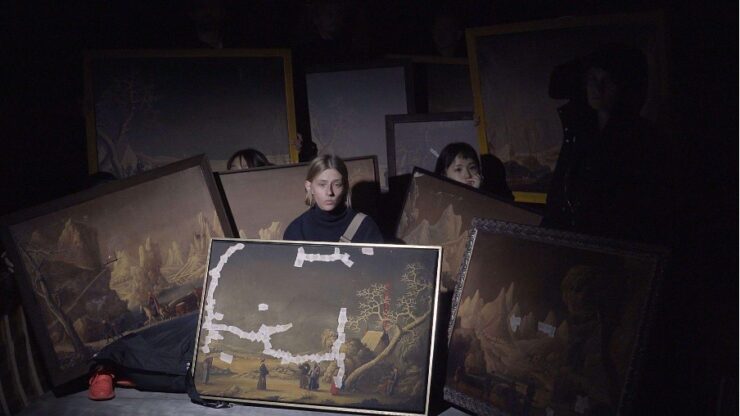Documentation
“Practical Inquiry as an Academic Grey Zone” – Kangning Li

Lee, Aram. Still from From A Dissonance of Landscapes, 00:03, 80min, Film, 2019. https://www.leearam.com/projects/a-dissonance-of-landscapes
Upon recalling the latest seminar/workshop on practical enquiry, the case which I found most relatable and familiar is the exhibition thesis Rewinding Internationalism. Both the approach and content of this project triggered my memory of a recent experience visiting the exhibition. Concerning the theme of this exhibition, its materialization and assemblage of ideas echoes the aim to explore the multitude of ‘Internationalism’ as construction (Aikens 3). By displaying individually imagined Internationalisms together, the collective assemblage invokes a critical re-thinking of the previous conception of Internationalism as a hegemonic illusion. Multitude is related to de-centralization and active participation from a political standpoint if we position it with Karen Barad’s agential realism or Donna Haraway’s Posthumanist reading of the cyborg. Both theories address the significance of multiple experiences in parallel to and as a potential break with the dominant discourse (Barad 802, Haraway 181). The alternative exists in between the tension of singular/multiple, imagined/realized and fiction/reality. Rewinding Internationalism seems to also reflect upon these tensions thus laying critical terrain for further enquiry. The format of the exhibition communicates how the individual imaginary and artistic production capture embodied and post-conscious experience which go beyond language.
This is maybe why practice-based research seems significantly more visible in Art History and Art-related research. For instance, an artistic approach which aims to reflect upon the archive of the museum has emerged in recent years. Fiona Tan’s project on inventory from Mountains and Molehills (2022), and Aram Lee’s A Dissonance of Landscapes (2019) invite viewers to rethink existing works and the discourse behind the museum as institution by re-narrating them. Curation projects like these form an alternative narrative and experience upon the canonized one. The chosen formats are more efficient and intriguing in comparison to conducting paper-based research. Nonetheless, not all of them seem to qualify as ‘artistic research’ and are often recognized similarly to literary critique. Even during the workshop, our group couldn’t help but approach the case-study through concepts and literary theories. Trained within the conventional pedagogical framework, I share a blind faith with the written-based research approach. Any alternative approach besides the familiar format seems to enter a grey zone; even if they do get recognition, it is never a fair match compared to the conventional plane.
The central question for this session seems to be the urgency to dismantle the hierarchy between the more conventional approach to conducting research and alternative inquiry methods. However, how shall we begin if we still believe the binary logic that practical inquiry differs from the theoretical? Categorization and classification continue to render practice-based research and alternative approaches as an academic grey zone.
References
Aikens, Nick. ‘Introduction.’ Rewinding Internationalism. Van Abbemuseum, 2023.pp.1-2
Barad, Karen. ‘Posthumanist Performativity: Towards an Understanding of How Matter Comes to Matter’. Signs: Journal of Women in Culture and Society. 28:3, (2003). pp.801-831.
Haraway, Donna. Simians, Cyborgs, and Women: The Reinvention of Nature. Taylor and Francis, 2013.

